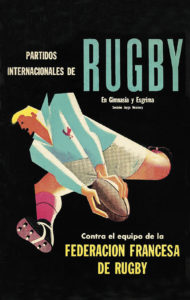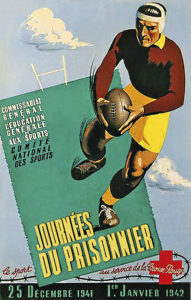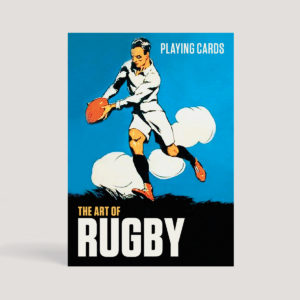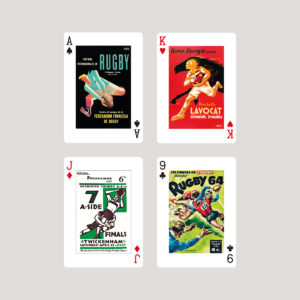 P.G. Wodehouse admitted to knowing little about rugby except that ‘each side is allowed to put in a certain amount of assault and battery and do things to its fellow man which, if done elsewhere, would result in 14 days, coupled with some strong remarks from the Bench’ (Very Good, Jeeves, 1930). Rugby is of course a collision sport, and as the French scrum half, Pierre Berbizier, said – ‘if you can’t take a punch, you should play ping pong’.
P.G. Wodehouse admitted to knowing little about rugby except that ‘each side is allowed to put in a certain amount of assault and battery and do things to its fellow man which, if done elsewhere, would result in 14 days, coupled with some strong remarks from the Bench’ (Very Good, Jeeves, 1930). Rugby is of course a collision sport, and as the French scrum half, Pierre Berbizier, said – ‘if you can’t take a punch, you should play ping pong’.
The origins of the game are shrouded in myth. Supposedly, in 1823 a scholar at Rugby School, William Webb Ellis, caught the ball in a soccer match (legal then) and ran with it, an infringement and certainly poor form. Ellis seems to have cheated, something his school report said he did at cricket. So the man who ‘invented’ rugby was a bounder. Later he became an evangelical preacher and a bit of a prig. What is not disputed is that in 1845 rules were drawn up at Rugby that became the basis for today’s game.
6 million people play rugby nowadays, in over 100 countries. The flagship tournaments are the Rugby World Cup (every 4 years), first held in 1987; and the Six Nations Championship (England, France, Ireland, Italy, Scotland and Wales), sponsored, appropriately, by Guinness, rugby being a game where you later drink beer with the man you’ve just flattened. There are equivalent women’s rugby tournaments, though as yet women and men don’t play together. Nothing to do with propriety, merely a case of men being horribly burly and lethal at speed. My brief playing career was marred by these muddied oafs. I agreed with Oscar Wilde – ‘Rugby is a good occasion for keeping thirty bullies far from the centre of the city.’
 Fittingly, in France where rugby is played with flair and elegance, it was sponsored by Byrrh, makers of a wine aperitif. The French are ‘predictably unpredictable’ but supporters want style, a rapier not a claymore. I met the great Jean-Pierre Rives once. What, I asked, did he enjoy most (expecting an answer like ‘a good 50/50 tackle’)? ‘Art Nouveau,’ he said. He is an artist. French rugby at its best is art on grass. The pictures in this pack are art from yesterday, symbols of a sport played for joy, when the game was simpler. But still illogical – a game played with a ball the wrong shape, with men the wrong size; and – if you’re in the scrum – with your head far too close to some bloke’s bottom.
Fittingly, in France where rugby is played with flair and elegance, it was sponsored by Byrrh, makers of a wine aperitif. The French are ‘predictably unpredictable’ but supporters want style, a rapier not a claymore. I met the great Jean-Pierre Rives once. What, I asked, did he enjoy most (expecting an answer like ‘a good 50/50 tackle’)? ‘Art Nouveau,’ he said. He is an artist. French rugby at its best is art on grass. The pictures in this pack are art from yesterday, symbols of a sport played for joy, when the game was simpler. But still illogical – a game played with a ball the wrong shape, with men the wrong size; and – if you’re in the scrum – with your head far too close to some bloke’s bottom.


